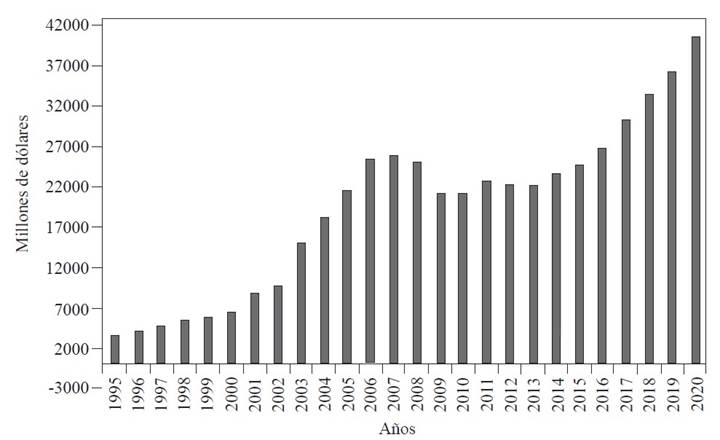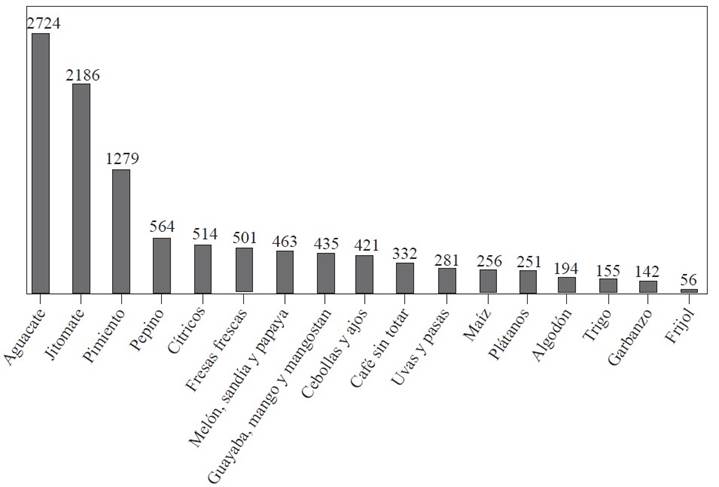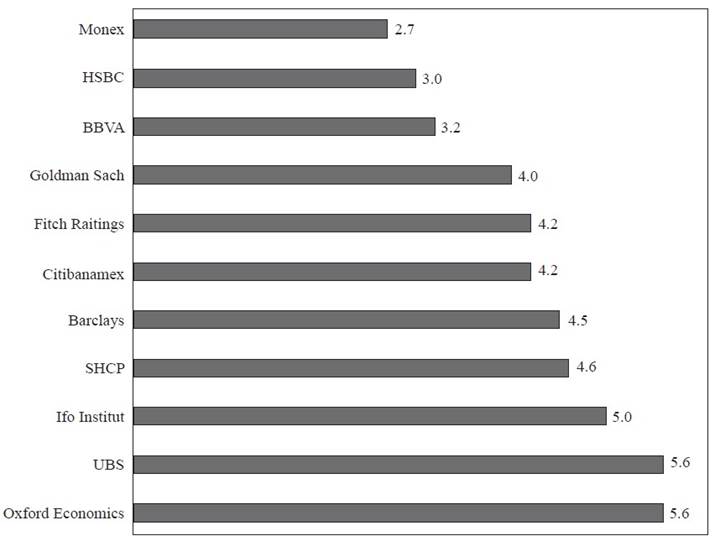COVID-19 and the mexican economy in 2020
Historic epidemics have taken place in Mexico with repercussions on the population and the economy of the country. Highlights include smallpox in 1520, a key event in the conquest of Mexico (Guevara-Flores, 2020), salmonella and typhus in 1545 and 1576, cholera in 1832, and the Spanish flu in 1918-19 (Malvido and Viesca, 1985). Recently, HIV has had its impact from 1985 to date, and Influenza A (H1N1) in 2009, the first pandemic of the 21st Century to be declared a public health emergency of international interest by the World Health Organization (WHO) (Córdova-Villalobos et al., 2019). The influenza virus caused 67 thousand positive cases and 265 deaths in Mexico (SSA, 2011) with losses calculated in 40 billion pesos and a decline of 5.1% of the Gross Domestic Product (GDP). On the other hand, SARS-CoV-2, which caused the current COVID-19 world health crisis, reduced it by 8.5% in 2020 and to an estimated 4% for 2021 (INEGI, 2021). In the purchase of vaccines alone, Mexico had spent 1.7 billion pesos until May of 2021 (https://expansion.mx/economia/2021/05/03/mexico-ha-pagado-17-000-m-en-la-compra-de-vacunas-anti-covid). Poverty rose from 48.8 to 56.7%, one of every 4 Mexicans now lives in extreme poverty due to low incomes and 24 federative entities presented an increase in labor poverty, with the highest impact observed in urban areas (CONEVAL, 2021). This document reviews the economic behavior of the agricultural sector in Mexico in a worldwide context in the first COVID-19 epidemic phase, between January of 2020, and March of 2021. The intention is to document the impact of COVID-19 on this sector and to offer an analysis that may contribute to the identification of opportunities. In addition, Mexico’s effort to align to Goal 8 of the 2030 Agenda 2030 for Sustainable Development of the UN: ‘Decent work and economic growth’, is emphasized, along with the invaluable contribution of the work by agricultural producers and farmers to achieve Goal 2: ‘Zero hunger’ (ONU, 2021).
Worldwide GDP and agricultural production in 2020
In 2020, once the first COVID-19 pandemic wave had taken place along with lockdown and the resulting reduction of non-essential activities, including the complete shutdown of activities in some countries, the demand for agricultural products increased worldwide. In addition, awareness grew in regard to human health and diets based on fresh products to strengthen the immune system and to contribute towards balanced diets. Diets high in saturated fats, sugars and refined carbohydrates not only favor the prevalence of chronic diseases such as obesity and diabetes, but also activate the innate immune system and deteriorate the adaptive immunity, leading to chronic inflammation and an inefficient defense against viruses and other agents (Butler and Barrientos, 2020). Although the risk of infection of farmers and agricultural workers threatened all productive processes and shrunk local markets, particularly urban wholesale food markets, agriculture in general did not suffer as much as the rest of the economy. In Mexico, agriculture was declared an essential economy, promoting the continuity of agricultural operations. However, later data show that the lethality of SARS-CoV-2 was higher in rural areas (12.4%) than in urban areas (8.4%) (Rodríguez, 2021), due largely to restrictions to primary and secondary health services.
In April of 2020, a fall in GDP was predicted, greater than any observed in decades (CEPAL, 2020). The International Monetary Fund (IMF) estimated a contraction of 3.5% for Latin America, 7.4% in the Caribbean and 8.5% in Mexico. This impact was even higher in developed economies such as the United Kingdom with 10% and Spain, 11.1%. During the entire pandemic, the Chinese economy stood out, since it maintained growth, albeit with a lower GDP than expected (2.3%) (Table 1) (IMF, 2021). The estimation of the Mexican economy in 2020 surpassed the fall of the 1932 Great Depression (Saldívar, 2021; Cruz-Vargas, 2021), and the 5.3% contraction caused by the Influenza A (H1N1) epidemic in 2009, as well as the one experienced by the ‘Tequila effect’ in 1995, with 6.9% (Morales, 2021).
In Mexico, with the motto ‘The countryside won’t stop’, the continuity in the production of many basic products was promoted. However, worldwide demand and the SARS-CoV-2 mitigation and prevention strategies implied the modification of production, distribution and marketing schemes. For example, Guanajuato, one of the main farming states, increased its production of tomato, bell peppers, lettuce, broccoli, cauliflower, and others by 12%, whereas the export of frozen plant-based foods such as broccoli, mixed vegetables, strawberries, etc. reached 22% (COFOCE, 2021). Similarly, rice harvests increased (23.3%; 302,000 t), along with beans (35.6%, 1,000,193 t), maize (3.9%, 28 000294 t) and wheat (17.5%, 1 000589 t) (SEGALMEX, 2020; Ramírez, 2021). Consequently, the total GDP of the primary farming activities had a growth, being the only one with a positive balance in comparison with other sectors of the economy. Thus, in the first quarter of 2020, a stationary series of 586,608 million pesos was registered; in the second quarter, during the quarantine period, the figure increased to 589,431 and in the third quarter, the value of primary activities surpassed expectations by 5.4% (636,317) for the annual cycle tendency (INEGI, 2021). On average, primary activities had an annual growth of 2.1% in that year. The secondary sector recorded an annual reduction of 10.2%, making it the most affected of the entire economy, due to the suspension of activities. The tertiary sector (tourism, trade and services) displayed an annual contraction of 7.9% (INEGI, 2021).
Table 1 Growth in GDP of the worldwide economy in 2020, and projections for 2021 and 2022 by regional average and for selected countries
| País | x2020 | 2021 | 2022 |
|---|---|---|---|
| Producto mundial | -3.5 | 5.5 | 4.2 |
| Economías Desarrolladas | -4.9 | 4.3 | 3.1 |
| Estados Unidos | -3.4 | 5.1 | 2.5 |
| Zona del euro | -7.2 | 4.2 | 3.6 |
| Alemania | -5.4 | 3.5 | 3.1 |
| Francia | -9.0 | 5.5 | 4.1 |
| Italia | -9.2 | 3.0 | 3.6 |
| España | -11.1 | 5.9 | 4.7 |
| Japón | -5.1 | 3.1 | 2.4 |
| Reino Unido | -10.0 | 4.5 | 5.0 |
| Canadá | -5.5 | 3.6 | 4.1 |
| Otras economías avanzadas | -2.5 | 3.6 | 3.1 |
| Economías emergentes y en desarrollo mundial | -2.4 | 6.3 | 5.0 |
| Economías emergentes y en desarrollo de Asia | -1.1 | 8.3 | 5.9 |
| China | 2.3 | 8.1 | 5.6 |
| India | -8.0 | 11.5 | 6.8 |
| ASEAN-5 | -3.7 | 5.2 | 6.0 |
| Economías emergentes y en desarrollo EU | -2.8 | 4.0 | 3.9 |
| Rusia | -3.6 | 3.0 | 3.9 |
| América Latina y el Caribe | -7.4 | 4.1 | 2.9 |
| Brasil | -4.5 | 3.6 | 2.6 |
| México | -8.5 | 4.3 | 2.5 |
| Oriente medio y Asia Central | -3.2 | 3.0 | 4.2 |
| Arabia Saudita | -3.9 | 2.6 | 4.0 |
| África subsahariana | -2.6 | 3.2 | 3.9 |
| Nigeria | -3.2 | 1.5 | 2.5 |
| Sudáfrica | -7.5 | 2.8 | 1.4 |
xSource: IFM (2021).
Mexican remittances in 2020
It is important to point out that in 2020, remittances, an important source of income from Mexicans living abroad, reached a historic peak of 3.8% of the GDP, or 40.6 billion dollars, 11.4% higher than in 2019 (BANXICO, 2021) (Figure 1). However, this is not an achievement of the mexican economy, since it is an outside variant, due to the effect of the productive economic incentives by the United States government that favored Mexican migrants (BBVA, 2021).
Source: BANXICO.
The mexican families that benefitted from remittances, mainly from rural areas, contributed significantly to the reactivation of internal consumption (BBVA, 2021). A total of 17 federative entities received at least 1 million dollars, the states of Jalisco and Michoacán receiving the highest benefits (BANXICO, 2021) (Figure 2). It is estimated that in the US live 12.4 million first-generation, 12.8 million second-generation and 13.9 million third-generation Mexicans (BBVA, 2021). The first generation is composed mainly of displaced field workers that migrated in search of better life and work options.
Source: BANXICO (2021).
Merchandise trade balance of Mexico in 2020
The total merchandise trade balance in 2020 recorded a surplus of 476 billion dollars, in a period in which exports were 9.0% higher than imports, caused by the increase in the positive balance of non-petroleum products by 81%, after going from 26.773 billion dollars to 48.471 billion dollars in 2020 (SIAP, 2021). This period experienced a deficit in the oil merchandise trade balance of 13.995 billion dollars. Historically, the secondary sector has been the one with the highest gains, largely due to oil extraction. However, in 2020 it underwent a contraction of 33.5%. Primary activities advanced 1.65%, which counteracted by the performance of secondary activities, composed of the industry, which had an annual fall of 10.2%. Meanwhile, tertiary activities, composed of the service sector, presented a lower contraction of 7.9%.
Mexico is positioned as the 12th agricultural producer and 3rd in Latin America, which favored a positive balance in 2020 (SIAP, 2021). The agri-food products balance ended with a surplus of 12.347 billion dollars, which meant an increase in the annual rate of 39.9%. Agri-food exports produced incomes for the country of 39.525 billion dollars, which represents a growth of 5.2% in regard to 2019. Imports fell 5.47% in comparison with the previous year, adding 127.178 billion dollars. Global agri-food trade was of 66.703 billion dollars, 59.2% of which were sales made by Mexico (Villalobos-Arámbula, 2021). At the end of 2020, the value of Mexican farming and fishing exports was the highest in 28 years, since 1993 (SIAP, 2021).
The fresh mexican products with the highest export value in 2020 were avocado (Persea americana), tomato (Solanum lycopersicum) and peppers (Capsicum sp.) with a value of 2.724, 2.186 and 1.279 billion dollars, respectively (Figure 3). These agricultural products come mainly from Michoacán (avocado), Sinaloa (tomato) and Chihuahua and Sinaloa (peppers) (SIAP, 2020). Other Mexican agricultural products that increased their value internationally were cucumbers (19%), green tomato (18.8%), cauliflower (18.0%), tomato (9.3%), broccoli (8.7%), zucchini (8.4%), onion (1.7%), asparagus (0.9%), chili pepper (0.9%) and carrot (0.2%) (Morales, 2020). Industrialized agricultural products that stand out are beer, with 4.685 billion dollars and tequila and mezcal, with 2.442 billion dollars (La Redacción, 2021). The highest increases in agricultural exports and its derivatives were in untoasted coffee, with an increase of 36%, followed by tomato (22.80%), onion and garlic (19.28%), strawberry and raspberry (18.54%) and cucumber (15.65%). Agroindustrial products such as tequila and mezcal grew by 24.33%, toasted and inflated 16.11%, water and soft drinks 15.33%, yeast 12.8% and bakery products 10.4% (Morales, 2021; SIAP, 2021). On the other hand, in 2020, the production of basic crops such as white maize and beans increased as predicted by SIAP. The production of beans in 2019 was 879,404 t and in 2020, 1,192,832. White maize went form 23,899,703 t in 2019 to 25,265,819 t in 2020 (SIAP, 2020).
Source: SIAP, (2021).
Plant health Politics
Mexico maintained its plant health policies, which focused on sustaining the health and innocuity of agricultural products, with an emphasis on basic products, during the period of pandemic in 2020 and 2021. Thus continued the Phytosanitary Epidemiological Surveillance Campaigns and Programs, crucial to reduce risks and productive losses, due to the effect of crop pests (https://prod.senasica.gob.mx/SIRVEF/). These activities included actions and surveillance in over 35 pests of importance for reasons of economy and/or quarantine. Several of these activities determine the issuance of export certificates, which favors the international marketing of Mexican fresh produce. Along with these efforts, on February 28, 2020, a pilot program was announced for the phytosanitary electronic certification (ePhyto) to speed up the commercial trade between Mexico and the United States (https://www.gob.mx/senasica/prensa/operan-mexico-y-estados-unidos-programa-piloto-de-certificacion-electronica-fitosanitaria-265245). Additionally, the Mexican Digital Counter for Foreign Trade (Ventanilla Digital Mexicana de Comercio Exterior - VDMCE), created in 2013, was crucial in this time of COVID-19 epidemic, since it has helped continue agricultural trade operations, improving the efficiency in the release of merchandise in points of entry. It was an instrument of the measures of the Mexican government to guarantee the trade and supply of foods, as well as contributing to prevent the spreading of SARS-CoV-2 by reducing the interaction between workers and users (https://www.yumpu.com/es/document/view/47818261/ventanilla-digital-mexicana-de-comercio-exterior-vdmce ) (SENASICA, 2021).
GDP estimations in 2021
Estimations for the Mexican and worldwide GDP in 2021 will depend largely on the advancement of vaccinations against SARS-CoV-2, which will allow total economic reactivation; however, recently approved fiscal and energy policies may decelerate growth, leaving an estimated GDP of 2.7 - 5.6% (Focus Economics, 2021) (Figure 4). Undoubtedly, a GDP growth of 4%, on average, with be attributable to the low GDP comparison in the same period of the previous year. At press time, with 2021 about to end and with 71,366,205 people vaccinated with at least one of the required doses, it is safe to claim that the economic deceleration forecast was not as expected and, in Mexico, is positioned higher than 5% (Editor’s note).
The repercussions of COVID-19 have impacted supply chains for food, inputs, services and workforce availability. By maintaining its productive activities, the countryside has posed challenges but also opportunities for innovation, such as digitalization in agriculture, communication and online trade. Regarding investigation opportunities, in this Special Edition, several authors point out the importance of promoting an agriculture based on the optimization of agroecosystemic services, the conservation and use of native plant materials as an alternative to an agriculture with a strong environmental impact and dependence on imported inputs (Editor’s note). Similarly, the World Bank (2021) suggests, in the light of the pandemic crisis, that “a measure with a possibly large impact will be to prioritize investment in ecological infrastructure projects with a high economic profitability. Promoting the adoption of environmentally sustainable technologies may support more growth, while mitigating the effects of climate change.”
Source: Focus Economics (2021).
Perspectives
By March 6, 2020, the number of deaths caused by SARS-CoV-2 in the world is higher than 2.5 million people, out of which 519,075 took place in the United States, 262,770 in Brazil and 189,578 in Mexico, with an average lethality of 8.95% (SSA, 2021; WHO, 2021). At time press, these numbers have increased by almost 50% in the USA and Mexico and by 100% for Brazil, indicating that the health crisis continues to be global, despite the strong vaccination campaigns in most countries, including those mentioned (Editor’s note). Mexican agriculture, as a primary essential activity, was the only one with a positive balance. Thus, the total GDP of the primary activities derived tom Mexican agriculture increased with a surplus of 12.347 billion dollars and an annual increase of 39.92% in 2020. Global economic implications of COVID-19 affected the supply chains of foods and agricultural inputs. However, this ‘new normality’ has produced challenges and opportunities for the primary sector, mainly agriculture. Despite, Mexican agriculture having adopted Good Agricultural Practices (GAP) and Good Manufacturing Practices (GMP) in the 1990s, for the production and marketing of innocuous foods, and the current demand for healthy agricultural products not having been a challenge for the supply of healthy foods, it did imply operative innovations to guarantee the reduction in the risk of contagion between agricultural workers and the potential risk of spreading inoculants in fresh foods (Editor’s note). This ability to adapt and the increase in the international demand for food can be of great benefit for agricultural producers. However, this area of opportunity for the Mexican countryside must quickly impact public policies and agricultural planning to maintain the productive rhythm while strengthening consumption and internal supply chains. Mexico has a diversity of production with small-, medium- and large-scale farmers, which supply anywhere from subsistence farming to the export of agricultural products, which translates into a large response potential in markets. It can also develop border investigation to achieve food security, which can be done with a greater efficiency, with more solid national policies.











 text in
text in 






